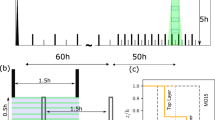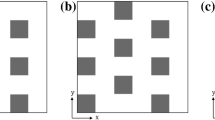Abstract
How to represent the effects of variable canopy morphology on turbulence remains a fundamental challenge yet to be confronted. Planar averaging over some minimal area can be applied to average-out this sort of spatial variability in the time-averaged mean momentum balance. Because of the multiply connected air-spaces, spatial averaging gives rise to covariance or dispersive stress terms that are produced by the spatial correlations of the time-averaged quantities. These terms are “unclosed” and require parameterization, which to date remains lacking due to the absence of data. Here, flume experiments were conducted to quantify the magnitude and sign of the dispersive stresses for a cylindric canopy where the rod density was varied but the individual rod dimensions (rod height h c and rod diameter d r) remained the same. Quadrant analysis was used to explore the genesis of their spatial coherency inside the canopy for a wide range of rod densities. When compared to the conventional turbulent stresses, these dispersive stresses can be significant in the lowest layers of sparse canopies. For dense canopies, the dispersive terms remain negligible when compared to the conventional momentum fluxes at all the canopy levels consistent with previous experiments in vegetated and urban canopies. It was also shown that the spatial locations contributing most to the dispersive terms were in the immediate vicinity downstream of the rods. In the deeper layers of sparse canopies, these positions contributed large and negative stresses, but in the upper levels of the canopy, they contributed large but positive stresses. Because the longitudinal velocity spatial perturbation \(({\bar{u}}^{\prime\prime})\) behind the rods is negative, the switch in sign in these stresses was connected with the sign of the vertical velocity spatial perturbation \(({\bar{w}}^{\prime\prime}).\) Simplified scaling arguments, using a reduced mean continuity equation and the vertical mean momentum balance for the flow field near the rods, offer clues as to why \({\bar{w}}^{\prime\prime} > 0\) in much of the lower canopy levels (about 0.75 h c ) while \({\bar{w}}^{\prime\prime} < 0\) in the upper canopy levels.








Similar content being viewed by others
References
Achenbach E (1968) Distribution of local pressure and skin friction around a circular cylinder in cross-flow up to Re = 5 × 106. J Fluid Mech 34:625–639
Belcher SE (2005) Mixing and transport in urban areas. Philos Trans R Soc Math Phys Eng Sci 363(1837):2947–2968
Bohm M, Finnigan JJ, Raupach MR (2000) Dispersive fluxes and canopy flows: just how important are they? In: American Meteorology Society, 24th conference on agricultural and forest meteorology, August 14–18, 2000, University of California, Davis, pp 106–107
Cava D, Katul GG, Scrimieri A, Poggi D, Cescatti A and Giostra U (2006) Buoyancy and the sensible heat flux budget within dense canopies. Bound Layer Meteorol 118(1):217–240
Cheng H, Castro IP (2002) Near wall flow over urban-like roughness. Bound Layer Meteorol 104(2):229–259
Christen A, Vogt R (2004) Direct measurement of dispersive fluxes within a cork oak plantation. In: 26th AMS conference on agricultural and forest meteorology, Vancouver
Coceal O, Thomas TG, Castro IP, Belcher SE (2006) Mean flow and turbulence statistics over groups of urban-like cubical obstacles. Bound Layer Meteorol 121(3):491–519
Finnigan J (2000) Turbulence in plant canopies. Ann Rev Fluid Mech 32:519–571
Harding DJ, Lefsky MA, Parker GG, Blair JB (2001) Laser altimeter canopy height profiles—Methods and validation for closed-canopy, broadleaf forests. Remote Sens Environ 76(3):283–297
Hsieh CI, Katul G, Chi T (2000) An approximate analytical model for footprint estimation of scaler fluxes in thermally stratified atmospheric flows. Adv Water Resour 23(7):765–772
Juang JY, Katul GG, Siqueira MBS, Stoy PC, Palmroth S, McCarthy HR, Kim HS, Oren R (2006) Modeling nighttime ecosystem respiration from measured CO2 concentration and air temperature profiles using inverse methods. J Geophys Res Atmos 111(D8)
Katul GG, Albertson JD (1998) An investigation of higher-order closure models for a forested canopy. Bound Layer Meteorol 89(1):47–74
Katul GG, Albertson JD (1999) Modeling CO2 sources, sinks, and fluxes within a forest canopy. J Geophys Res Atmos 104(D6):6081–6091
Katul GG, Chang WH (1999) Principal length scales in second-order closure models for canopy turbulence. J Appl Meteorol 38(11):1631–1643
Katul G, Hsieh CI, Bowling D, Clark K, Shurpali N, Turnipseed A, Albertson J, Tu K, Hollinger D, Evans B, Offerle B, Anderson D, Ellsworth D, Vogel C and Oren R (1999) Spatial variability of turbulent fluxes in the roughness sublayer of an even-aged pine forest. Bound Layer Meteorol 93(1):1–28
Katul GG, Mahrt L, Poggi D, Sanz C (2004) One- and two-equation models for canopy turbulence. Bound Layer Meteorol 113(1):81–109
Katul GG, Porporato A, Nathan R, Siqueira M, Soons MB, Poggi D, Horn HS, Levin SA (2005) Mechanistic analytical models for long-distance seed dispersal by wind. Am Nat 166(3):368–381
Lefsky MA, Cohen WB, Parker GG, Harding DJ (2002) Lidar remote sensing for ecosystem studies. Bioscience 52(1):19–30
Macdonald RW (2000) Modelling the mean velocity profile in the urban canopy layer. Bound Layer Meteorol 97(1):25–45
Macdonald RW, Coulson BJ, Slawson PR (2000) Near field dispersion in the urban environment—a hydraulic flume study. Environ Monitor Assess 65(1–2):231–238
Martilli A, Santiago JL (2007) CFD simulation of airflow over a regular array of cubes. Part II: analysis of spatial average properties. Bound Layer Meteorol 122(3):635–654
Nathan R, Katul GG (2005) Foliage shedding in deciduous forests lifts up long-distance seed dispersal by wind. Proc Natl Acad Sci USA 102(23):8251–8256
Nathan R, Katul GG, Horn HS, Thomas SM, Oren R, Avissar R, Pacala SW, Levin SA (2002) Mechanisms of long-distance dispersal of seeds by wind. Nature 418(6896):409–413
Nepf HM, Koch EW (1999) Vertical secondary flows in submersed plant-like arrays. Limnol Oceanogr 44(4):1072–1080
Nikora V, Goring D, McEwan I, Griffiths G (2001) Spatially averaged open-channel flow over rough bed. J Hydraul Eng ASCE 127(2):123–133
Parker GG, Lefsky MA, Harding DJ (2001) Light transmittance in forest canopies determined using airborne laser altimetry and in-canopy quantum measurements. Remote Sens Environ 76(3):298–309
Poggi D, Katul GG (2006) Two-dimensional scalar spectra in the deeper layers of a dense and uniform model canopy. Bound Layer Meteorol 121(2):267–281
Poggi D, Katul GG (2007) Turbulent flows on forested hilly terrain: the recirculation region. Q J R Meteorol Soc 133(625):1027–1039
Poggi D, Porporato A, Ridolfi L (2003) Analysis of the small-scale structure of turbulence on smooth and rough walls. Phys Fluids 15(1):35–46
Poggi D, Katul GG, Albertson JD (2004a) Momentum transfer and turbulent kinetic energy budgets within a dense model canopy. Bound Layer Meteorol 111(3):589–614
Poggi D, Katul GG, Albertson JD (2004b) A note on the contribution of dispersive fluxes to momentum transfer within canopies—research note. Bound Layer Meteorol 111(3):615–621
Poggi D, Porporato A, Ridolfi L, Albertson JD, Katul GG (2004c) The effect of vegetation density on canopy sub-layer turbulence. Bound Layer Meteorol 111(3):565–587
Poggi D, Katul GG, Albertson JD, Ridolfi L (2007) An experimental investigation of turbulent flows over a hilly surface. Phys Fluids 19(3)
Pokrajac D, Campbell LJ, Nikora V, Manes C, McEwan I (2007) Quadrant analysis of persistent spatial velocity perturbations over square-bar roughness. Exp Fluids 42(3):413–423
Raupach MR, Shaw RH (1982) Averaging procedures for flow within vegetation canopies. Bound Layer Meteorol 22(1):79–90
Raupach MR, Coppin PA, Legg BJ (1986) Experiments on scalar dispersion within a model-plant canopy. 1. The turbulence structure. Bound Layer Meteorol 35(1–2):21–52
Ruck B, Adams E (1991) Fluid mechanical aspects of the pollutant transport to coniferous trees. Bound Layer Meteorol 56(1–2):163–195
Siqueira M, Lai CT, Katul G (2000) Estimating scalar sources, sinks, and fluxes in a forest canopy using Lagrangian, Eulerian, and hybrid inverse models. J Geophys Res Atmos 105(D24):29475–29488
Soons MB, Heil GW, Nathan R, Katul GG (2004) Determinants of long-distance seed dispersal by wind in grasslands. Ecology 85(11):3056–3068
Acknowledgments
This research was supported, in part, by the National Science Foundation (NSF-EAR 06-35787 and NSF-EAR-06-28432), the United States-Israel Binational Agricultural Research and Development (BARD, Research Grant No. IS3861-06), and the US Department of Energy (DOE) through the office of Biological and Environmental Research (BER) Terrestrial Carbon Processes (TCP) program (Grants # 10509-0152, DE-FG02-00ER53015, and DE-FG02-95ER62083).
Author information
Authors and Affiliations
Corresponding author
Rights and permissions
About this article
Cite this article
Poggi, D., Katul, G.G. The effect of canopy roughness density on the constitutive components of the dispersive stresses. Exp Fluids 45, 111–121 (2008). https://doi.org/10.1007/s00348-008-0467-7
Received:
Accepted:
Published:
Issue Date:
DOI: https://doi.org/10.1007/s00348-008-0467-7




